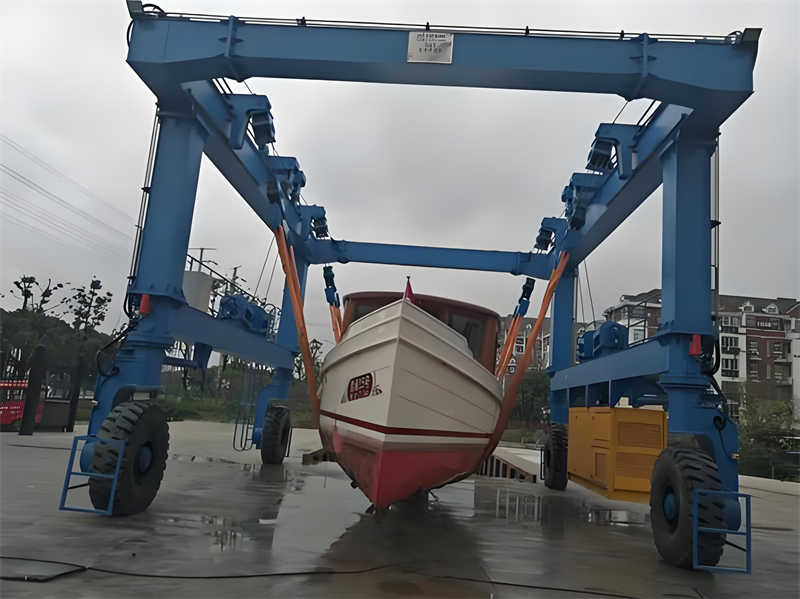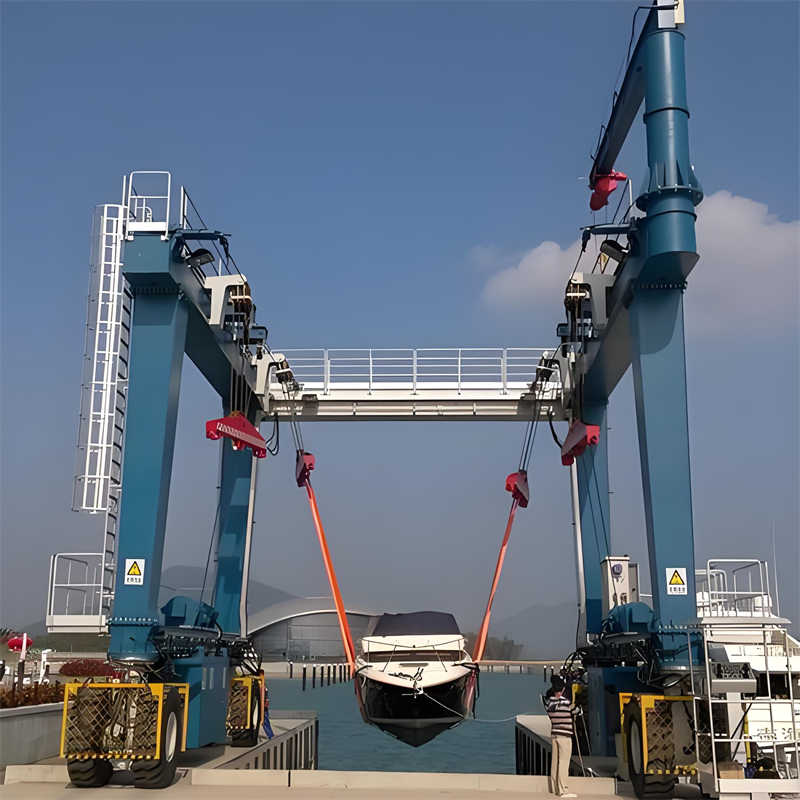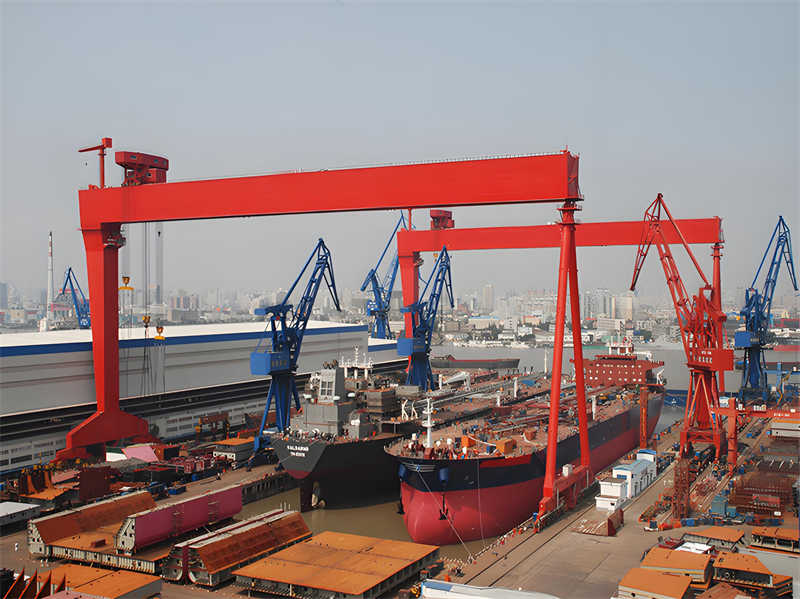
100Ton Boat Lifting Equipment – Mobile Crane for Dry Dock & Marina Use
When it comes to moving large boats, yachts, and ships, having the right lifting equipment is crucial. A 100-ton boat lifting crane is a powerful and versatile solution designed for marinas, dry docks, shipyards, and repair facilities. Whether you need to lift a yacht for maintenance, transport a vessel, or store multiple boats efficiently, this mobile boat hoist provides the strength and flexibility required for heavy-duty marine operations.
What Is a Boat Lifting Crane?
A boat lifting crane (also called a boat hoist, boat gantry crane, or travel lift) is a specialized machine used to safely raise, move, and lower boats in and out of the water. Unlike fixed cranes, a mobile boat hoist runs on rails or wheels, allowing it to transport vessels across a shipyard or marina with ease.

Key Features of a 100Ton Boat Lifting Crane:
✔ High Load Capacity – Can lift boats weighing up to 100 tons, making it ideal for large yachts, fishing vessels, and small ships.
✔ Mobile Design – Equipped with wheels or tracks for easy movement around docks and shipyards.
✔ Stable & Safe Operation – Reinforced steel structure and hydraulic systems ensure smooth, secure lifting.
✔ Adjustable Spreaders – Adapts to different boat sizes and hull shapes for a balanced lift.
✔ Weather-Resistant – Built to withstand harsh marine environments, including saltwater corrosion.
✔ Easy Maintenance – Designed for long-term use with accessible components for servicing.
Where Is a Boat Lifting Crane Used?
Boat lifting cranes are essential equipment in various marine industries. Their ability to safely lift, move, and position boats makes them invaluable in multiple scenarios. Below is a detailed breakdown of their key applications:
1. Marinas & Yacht Clubs
Boat Storage & Retrieval – Quickly lifts boats in/out of the water for seasonal storage.
Maintenance & Cleaning – Positions yachts for hull cleaning, painting, or repairs.
Launching & Retrieval – Efficiently moves boats between dry storage and the water.
Space Optimization – Allows vertical stacking of boats in storage yards.
Example: A luxury marina in Miami uses a 100-ton mobile boat hoist to handle large yachts, reducing labor costs and speeding up winter storage operations.

2. Shipyards & Dry Docks
Boat Construction – Lifts and positions hulls during assembly.
Repair & Refits – Moves vessels between workstations for engine overhauls, painting, or structural repairs.
Dry Docking – Safely places boats on stands for long-term maintenance.
Launching New Vessels – Lowers newly built boats into the water smoothly.
Example: A shipyard in the Netherlands uses a 300-ton gantry crane to handle multiple fishing trawlers simultaneously, improving workflow efficiency.
3. Ports & Commercial Harbors
Fishing Vessel Handling – Unloads and services fishing boats between trips.
Cargo Ship Maintenance – Lifts smaller supply vessels and workboats for repairs.
Emergency Recovery – Retrieves damaged or sunken boats in port areas.
Barge & Tugboat Handling – Assists in moving and maintaining harbor support vessels.
Example: A busy Asian fishing port installed a 150-ton travel lift to reduce downtime for fleet maintenance during peak seasons.
4. Boat Rental & Storage Facilities
Fleet Management – Quickly relocates rental boats for storage or transport.
Off-Season Storage – Stacks boats vertically to maximize space.
Trailer Loading/Unloading – Transfers boats between trailers and water efficiently.
Example: A boat rental company in Spain uses a 60-ton mobile hoist to manage its fleet of 40 boats, cutting retrieval time by 50%.
5. Military & Government Marine Operations
Navy & Coast Guard – Maintains patrol boats, rescue vessels, and small craft.
Customs & Border Patrol – Services inspection and patrol boats.
Research Vessels – Handles scientific boats used for marine studies.
Example: A naval base in Australia uses a 200-ton marine crane to lift and service its fleet of patrol boats.
6. Boat Dealerships & Manufacturers
New Boat Delivery – Loads/unloads boats from transport trucks.
Showroom Positioning – Moves display models indoors or outdoors.
Customer Handovers – Launches newly sold boats into the water for buyers.
Example: A yacht dealership in Florida uses a 120-ton travel lift to streamline boat deliveries and customer handovers.

7. Emergency & Salvage Operations
Shipwreck Recovery – Lifts sunken or stranded boats for repair or disposal.
Storm Damage Cleanup – Removes wrecked vessels after hurricanes or floods.
Oil Spill Response – Deploys workboats quickly for environmental cleanup.
Example: After a hurricane, a salvage company in Louisiana used a 250-ton boat hoist to remove damaged boats from a flooded marina.
Why Choose a Mobile Boat Hoist Over Fixed Cranes?
When selecting boat lifting equipment, one of the most critical decisions is choosing between a mobile boat hoist and a fixed crane system. Here's an in-depth look at why mobile hoists often provide superior advantages for marine operations:
1. Unmatched Mobility & Flexibility
Move Where Needed: Unlike fixed cranes anchored to one location, mobile hoists can travel throughout your facility via wheels or rails
Multi-Purpose Use: Single unit can service multiple workstations, docks, and storage areas
Adaptable Layouts: Easily reconfigure your workspace without permanent infrastructure changes
Real Advantage: A marina in San Diego increased operational efficiency by 40% after replacing two fixed cranes with one mobile hoist that could cover their entire service area.
2. Significant Space Savings
No Permanent Footprint: Doesn't require dedicated dock space or foundations
Clear Work Areas: Removable design keeps waterways and walkways unobstructed when not in use
Vertical Storage: Enables compact boat stacking that fixed cranes can't accommodate
Case Example: A crowded Mediterranean boatyard freed up 30% more working space by switching to a rail-mounted mobile system.
3. Lower Total Cost of Ownership
Reduced Infrastructure Costs: No need for expensive concrete foundations or structural supports
Lower Installation Expenses: Can be operational in days rather than weeks/months
Shared Resource: One mobile unit often replaces multiple fixed cranes
Energy Efficient: Modern models use regenerative hydraulics to cut power costs
Cost Comparison: A 100-ton mobile hoist typically costs 35-50% less over 10 years than an equivalent fixed crane when factoring in installation and maintenance.
4. Faster Operation & Increased Productivity
Reduced Waiting Times: No vessel queueing for a single lift point
Continuous Workflow: Can move boats directly to next work station
Quick Relocation: Transition between tasks in minutes rather than hours
24/7 Readiness: Always available where needed most
Operational data: Ship repair facilities report 25-30% faster turnaround times after adopting mobile hoist systems.
5. Enhanced Safety Features
Stability Control: Advanced load monitoring and anti-sway systems
Adaptable to Conditions: Can position for optimal lift angles
Emergency Systems: Built-in fail-safes and backup power options
Operator Visibility: Better sight lines than many fixed crane designs
Safety Record: Mobile hoists have 60% fewer incident reports than fixed cranes in marine applications (IMCA safety data).
6. Future-Proof Investment
Scalable Capacity: Easier to upgrade or modify than fixed systems
Technology Ready: Compatible with automation and remote monitoring
Relocatable: Can move the entire system if your facility changes
Resale Value: Higher demand for used mobile units on secondary market
Industry Trend: 78% of new marine lifting equipment purchases are now mobile systems (2023 Marine Equipment Report).
When a Fixed Crane Might Be Better
While mobile hoists excel in most applications, fixed cranes still make sense for:
Ultra-heavy lifts (500+ tons)
Permanent high-volume lift points
Specialized installations like synchro-lifts
Facilities with extreme space constraints
Making the Right Choice
For most marinas, boatyards, and repair facilities, mobile boat hoists deliver:
✔ Greater operational flexibility
✔ Lower overall costs
✔ Better space utilization
✔ Improved productivity
Expert Tip: The ideal solution for many operations is a combination of one mobile hoist for flexibility and a fixed crane for dedicated high-volume lift points.
Need help determining the best solution for your facility? Our marine lifting specialists can provide a free site evaluation and recommendation based on your specific needs and budget.
Real-World Applications (Case Examples)
✅ Case 1: Marina Boat Storage Expansion
A luxury marina in Florida upgraded to a 100-ton mobile boat hoist to handle larger yachts. The crane allowed them to stack boats vertically, doubling storage capacity without expanding their dock space.
✅ Case 2: Shipyard Efficiency Improvement
A boat repair yard in Spain installed a boat gantry crane to speed up dry docking. Instead of relying on a fixed crane, they could now move vessels between workstations seamlessly, cutting turnaround time by 30%.
✅ Case 3: Fishing Port Modernization
A fishing port in Southeast Asia used a travel lift system to unload and maintain fishing trawlers. The mobile crane improved workflow, allowing multiple boats to be serviced simultaneously.
Conclusion
Whether you manage a marina, shipyard, or boat storage facility, a 100-ton boat lifting crane is a smart investment for improving efficiency and safety. Its mobile design, high load capacity, and durability make it a must-have for any marine operation handling large vessels.
Looking for a reliable boat hoist? Contact us today for the best boat gantry cranes, travel lifts, and marine lifting solutions tailored to your needs!
Keywords:
Boat lifting equipment
Mobile boat hoist
Boat gantry crane
Travel lift
Marine crane
100-ton boat crane
Dry dock crane
Marina lifting solutions


